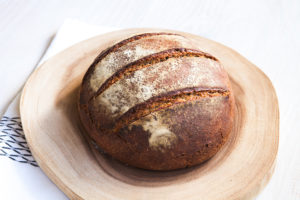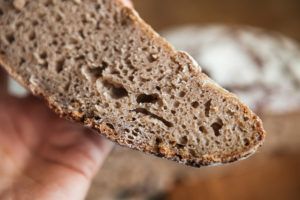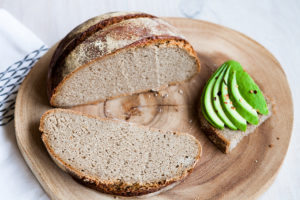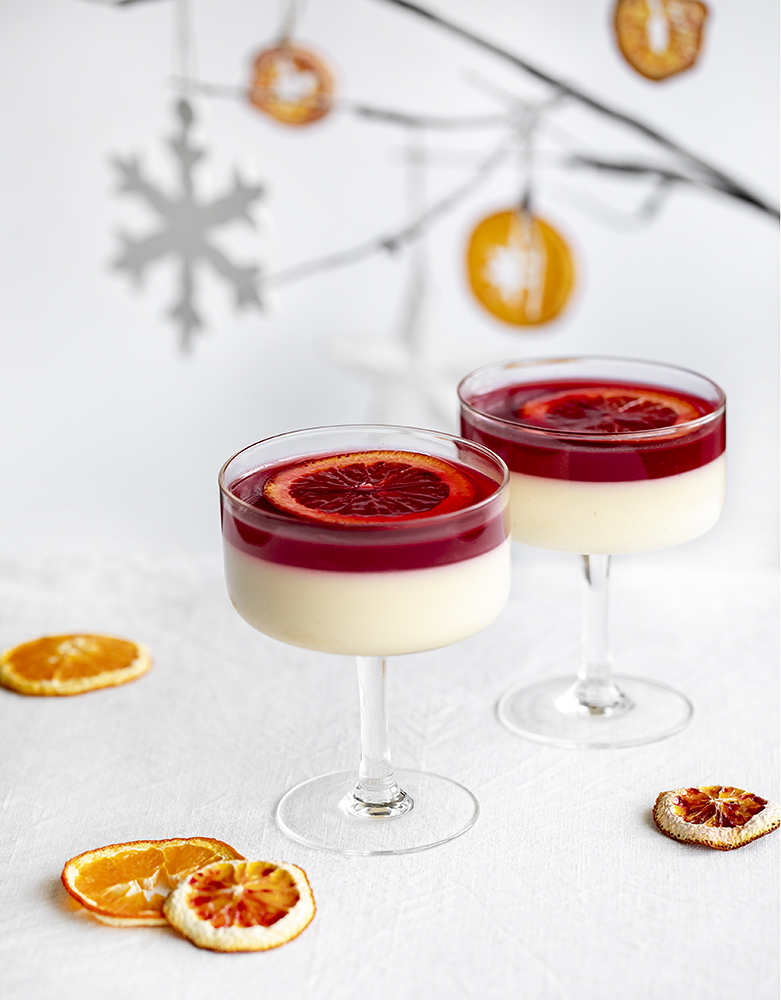
Rye sourdough bread is one of my favorite. You may say “Because you are originally from Russia”. And this is absolutely right. This kind of bread very popular in Russia and all around Europe.
European rye breads tend to be dense, sour, somewhat moist, and earthy in flavor. Rye bread contains a large amount of fiber and a small amount of fat. Rye bread has a lower glycemic index than white bread which means it causes less of an increase in blood sugar.
Rye sourdough bread quite hard to find in New Zealand. Typically I need to visit the Sunday market for this. The price of such bread about $ 8 a loaf. It is a bit more expensive then other kind of breads. The reason is that this is a complex process which requires high-quality ingredients.
I’m prefer to not buy bread from supermarket. Usually it made from refined flour, soybean, palm oil, emulsifiers, acidity regulator and a large portion of the additional gluten.Gluten makes bread soft and fluffy as well increases the shelf life. Unfortunately such a large amount of gluten may causes allergy. One of the main reason why gluten allergy going so common is low-quality cheap bread. For a gluten-free version is usually used starch, which also is not so good for health and as result modern version of bread is not a source of fiber anymore.
One of the world’s oldest sourdough bread is only 3 ingredients – flour, water and salt.
I spent five days for the production of sourdough rye starter, one night for loaf fermentation, one hours for baking and few kilos of rye flour. This is pure magic of fermentation process and real meditation for me. Now I enjoy a natural delicious bread with a crispy crust. I`m so happy with result!
Part 1. Rye Sourdough Starter
Sourdough bread is made by the fermentation of dough using naturally-occurring lactobacilli and yeast. It has a mildly sour taste not present in most breads made with baker’s yeast and better inherent keeping qualities than other breads, due to the lactic acid produced by the lactobacilli.
For making bread, we need a starter. For my sourdough baking I use a culture which is made with 100% whole rye flour.
Ingredients
For starter- 60g Rye Flour, sifted
- 60g Warm Water
For every feeding you need:
- 60g Rye Flour, sifted
- 60g Warm Water
Directions
For measuring I usually use standart cup 235ml. So we need 1/2 cup rye flour and 1/3 cup warm water.
Combine sifted rye flour and warm water in a glass bowl or jar. Mix well till smooth. Cover cling wrap. Using a sharp knife make a few holes in it for air circulation. Store at room temperature (about 20-21C/68-69F) out of direct sunlight for 24 hours.
After 24 hours to feed starter with another 1/2 cup of rye flour and 1/3 cup of warm water. Mix well and cover cling wrap with few holes .Store at room temperature (about 20-21C/68-69F) out of direct sunlight for 24 hours. Repeat this step with feeding every day. After 2-3 days you can watch activities – bubles and sour smell. The starter will grow and will reach the double volume. For best result cultivate the starter up to 5 days.
For further storage and use, we need only 50g of starter. This amount of starter I put into clean glass bowl and feed every day or few days. It’s very important don`t forget to feed the starter before 24 hours of bread making.
In winter, the fermentation process is slowed down due to low temperatures. See how it feels to starter. If no bubbles suggests that it is time for feeding. As long as this starter culture get flour and water regularly it will remain active. Watch carefully to avoid mold growth on the surface of the starter. Use a clean jar and spoon when feeding.
Activity leaven develops over time. Very active sourdough starter can raise the bread just a few hours.
Part 2. Breadmaking.
Ingredients
NOTE I use ratio 1:2:3.- 200g /1 Cup/235ml Rye Sourdough Starter
- 400 ml Warm Water
- 600 g Rye Flour, sifted + some for dusting
- 12g Sea Salt
+ Baking tray, Baking stone and Baking rack
Directions
Dissolve the salt in warm water. Combine with starter and stir well. Then add the sifted flour and mix with a wooden spoon until combined. Work until a smooth dough forms.
Put the dough onto a work surface and knead for five minutes. This dough is very sticky and you do not want to add more flour to it in the process. The best way to do this is to wet your hands. Use a dough scraper if the dough sticks to the surface. Flatten the dough into a circle. Fold the outer edge into the center and press it down with the heel of your hand, turn the dough and repeat the process several times. Place it in big bowl or round bread proofing basket with good layer of flour dusting. Cover damp tea towel. Allow the dough to rise and to fermented at room temperature until it doubles in volume, approximately for 6 hours or overnight. If you want to force up the process for shorter rise, place the dough in a warm place near the heater. I like to use a 50C oven mode. But for long-term process it is preferred to keep the dough at room temperature to prevent too sour taste.

Rye Sourdough Bread after 16 hours of fermentation/rise
Preheat the oven, baking stone and baking tray up to 220C/430F. Prepare 1 cup of boiling water.
Dust hot baking stone with flour and place the dough. Score the top bread of using a very sharp knife. Remove excess of flour on baking stone, it prevent flour burning.
Place the dough in the hot oven. Same time pour a cup of boiling water to baking tray at the bottom and immediately close the oven door. We need the steam to form a crispy delicious crust.
After 10 minutes remove tray with excess of water. Turn the oven down to 200C/400F. Bake 45-50 minutes. Transfer to a wire rack to cool.
How to check when Bread is Done. Take the loaf out of the oven and turn it upside down. Give the bottom of the loaf a firm thump! with your thumb, like striking a drum. The bread will sound hollow when it’s done. If you’re new to this technique, try doing this every five minutes toward the end of baking and you’ll hear how the sound changes.
My favorite combination with rye sourdough is Kiwi style Breakfast and Eggplant Bruschetta on Rye. Delicious!

Thanx for music: Bensound.com


